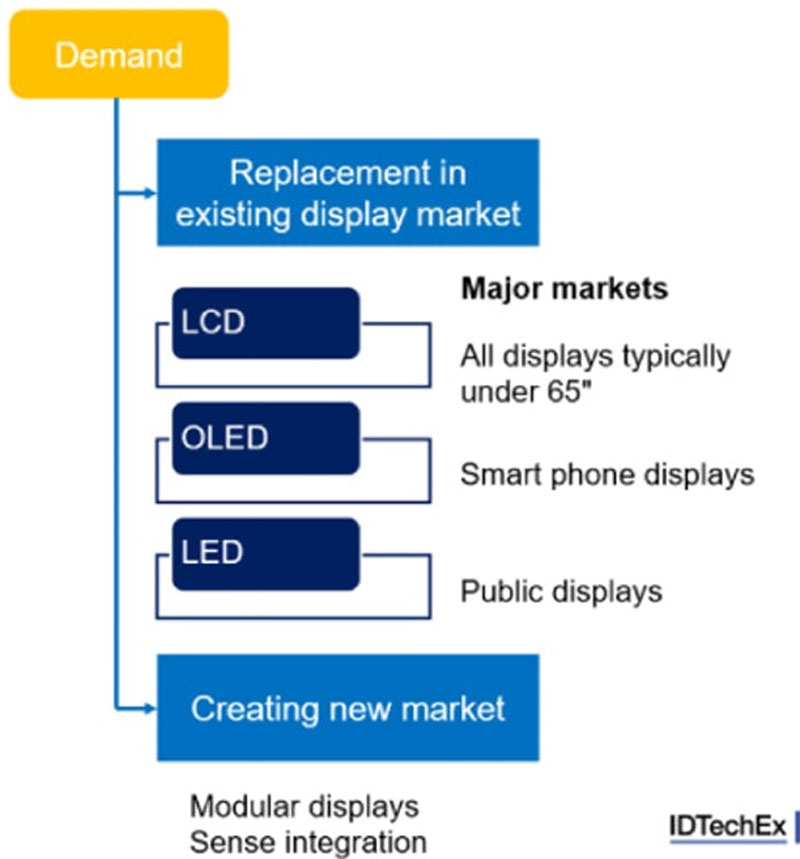A glance at the latest features in digital displays and the technology that’s behind it
2021 Digital Signage Display Report


Digital Signage displays have come a long way. The good old cathode ray tube (CRT) technology for televisions, that was housed in a big box, was revolutionary at its introduction, but now practically extinct.
Over the years, of course, new digital display technologies significantly outshone it in features and cost effectiveness.

So before we venture into display technology, lets go through some features in digital displays that I came across in exhibitions, research papers and articles. These are 5 trends I saw that I particularly found interesting:
1. a. Rollable TV’s
One of the hottest innovations in televisions was showcased at CES recently – LG’s incredible rollable TV, a 65-inch OLED television that’s ‘foldable’ – it actually rolls up out of a horizontal cabinet base. When stacked in front of your bed, it is perfect to unveil and watch television, and other times can be used as a seat and music player. All in all, quite unreal – check it out below:
5 roll-up OLED TVs at LG's #CES2019 booth. Mesmerizing. pic.twitter.com/0k56LVuABb
— David Katzmaier (@dkatzmaier) January 8, 2019
1. b. Rollable & foldable phones:
Rollable & foldable phones are pretty mind-blowing as well since, in a sense, they can potentially convert a phone into a tablet! Check out this video to understand this:
2. Haptics
Another interesting upcoming feature in display is called ‘haptics’.
With haptics, one can ‘feel’ the screen which creates sensations when touched.
Imagine buying a top/ shirt on Amazon: With this great feature, you could actually feel the cloth before buying it. A very interesting technology which allows the sense of ‘touch’ to be enabled on displays, in addition to visual (screen) and audio (speakers).
3. Bendy-Flexi-See-through OLED’s
LG Displays showcased a whole host of features pumped into their OLED this year – from see-through displays to bendable ones. Watch this stunning video.
The applications of see-through displays are no-doubt interesting. Almost 60% of the screen surface is see-through, so displays can effectively be used in fast food restaurant counters – wherein one can view the display as well as the person on the counter behind it. Particularly useful in the Covid-19 pandemic as well- to create a shield between customer and store personnel.
The bendable displays have an interesting application in gaming too – they create an immersive experience for games, given that the screens are bent and aligned to the way we actually see. Check out the video to understand this!
4. Augmented Reality (AR) / Virtual Reality (VR)

This interactive virtual concierge robot is an example of AR at work, and was showcased in a recent symposium for Digital Displays. The concierge was charming, almost human-like, and interacted with customers socially about products. For example, she waved her hand to attract the attention of potential customers. She then had a social conversation and conveyed salient points about products, and answered questions along the way – just as a store personnel would do!
The assistant was actually projected on glass that can serve as a transparent glass ordinarily, and then as a projection screen for augmented reality, when required.
Given an advanced ability to interact, one can imagine the possibilities this opens up – contactless shopping, personnel-less stores, to name a few.
Many such applications around AR and VR are slowly unfolding.
5. Coloured e-ink and more
This is a display system I am particularly quite interested in – of course, best known from the Kindle displays.
They are drastically different from regular displays, and bring forth their own set of advantages. The people at E-ink rightly point out, that the technology is not meant to be a replacement for digital displays, but for paper!
Its advantages like extremely long battery life, very low power requirement, no eye strain and artistic appearance, completely disrupt the space. However, limitations like able to only display images (not videos), very low refresh rate, and so on, make it placed in a completely different segment from digital displays.
In its independent space, e-ink technology is now releasing features of enabling colour, currently at 4096 shades of colours and around 16 levels of grayscale. Great space to keep a tab on!

Now most of the above advanced features are still not out in the mass market, since they aren’t cost-effective as yet for being adopted. However, thanks to the speed of R&D we will get there soon!
The features, of course, are only possible thanks to advanced display technologies.
In this next section, let’s take a look at how display technologies have evolved over time, and made the features we saw earlier possible. Here’s the evolution of display technologies:
The well-known Liquid Crystal Display (LCD)
In the year 2007, the image quality of LCD displays surpassed that of the traditional CRT TV’s. And almost immediately towards the end of the year, there was a formidable shift in the space – more LCD’s were shipped as compared to CRT’s. And over time, of course, CRT’s were rendered extinct!

LCD Screens and their evolutions
LCD’s, in order to make images visible, need a backlight. Earlier this light was in the form of CCFL’s (cold cathode fluorescent lamps) which were placed on the opposite edges of the display. This was the key technology used for many years.
However, with time, CCFL’s began getting replaced by LED’s (Light Emitting Diodes) which were more efficient than CCFL’s.
Did you know that the LED televisions we see today are basically LED backlit LCD displays? Unlike what people presume, they aren’t ‘LED televisions’ in themselves. Pure LED’s still command a premium price, but are slowly making their in-roads to the mass market.
The New Age LED’s: The era of LED, OLED, QLED and AMOLED
Outdoor displays use the pure form of LED’s, since they are generally seen from a distance and need to be bright, given the daylight. They are useful for outdoor billboards, but generally not used indoors.
OLED which stands for Organic Light emitting diode, is actually a pure LED technology for indoor displays.
Followed by QLED & AMOLED, and others, which for understanding sake, are essentially variations of the OLED.
The advantages are that they produce a much higher quality output versus previous technologies, they are brighter, require no backlighting and also produce ‘true blacks’.
The current LED’s, due to backlight, are not capable of producing deep blacks. Whereas, since OLED’s are lighted up by individual pixels, they do not produce light when off and remain totally black.

Traditional LED’s (LED backlit LCD’s) versus OLED’s
These new-age LED’s are now being adopted, and LCD is on the decline, similar to how, in fact, LCD’s had overtaken CRT’s way back in 2007.
Samsung and LG, recently, both halted their domestic production of their traditional LCD’s to focus more on these newer LED technologies.

Demand and supply of Micro LED displays. Source: IDTechEX
The Future LED’s: Micro LED’s
Micro LED’s are what many believe to be the next generation of display technology. MicroLED displays offer a wide range of additional features such as wide colour gamut, high luminance and contrast, wide view angle, transparency, seamless connection, and sensor integration capability, among others.
Most of the advanced features which are releasing now like bendable, foldable and see through displays, like we saw earlier, are thanks to this technology.
Given the possibility of sensor integration, it can also engage with audiences.
Advanced technologies like cloud, ML & AI integrated with the displays are able to create the virtual concierge that we saw earlier.
Here is a handy graph that summarizes these display technologies.

Value propositions of various display technologies. Source: IDTechEx
E-paper, of course, being in a separate segment, and as explained earlier is not included in the comparison, but is an interesting technology in itself.
So that sums up an overview of the latest trends that we see in display signages and the host of features and possibilities that it opens up.
As a result of this, I see many interesting applications of digital signages and digital displays, that will make their way through and affect industries like consumer, retail, advertising, hospitality, and more.
After all, looking fundamentally, effective communication and engagement with customers across industries will lead to a higher output.
It’s an exciting road ahead in the digital signage and digital display space and I, for one, can’t wait to experiment on prototypes and build products using these new technologies!
Sources:
- https://www.idtechex.com/en/research-article/microled-displays-getting-ready-for-the-future/21352
- https://electronics.howstuffworks.com/everyday-tech/haptic-technology.htm
- https://goodereader.com/blog/electronic-readers/color-e-ink-for-large-displays-will-be-released-this-year
- https://www.cnet.com/news/microled-could-soon-replace-oled-screens-samsung-first-line-try/





